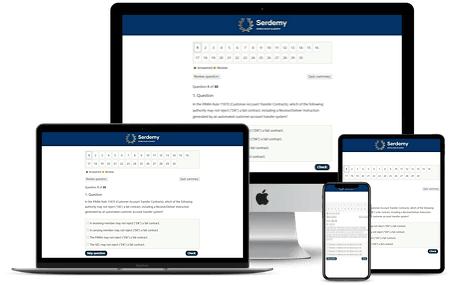Quiz-summary
0 of 30 questions completed
Questions:
- 1
- 2
- 3
- 4
- 5
- 6
- 7
- 8
- 9
- 10
- 11
- 12
- 13
- 14
- 15
- 16
- 17
- 18
- 19
- 20
- 21
- 22
- 23
- 24
- 25
- 26
- 27
- 28
- 29
- 30
Information
Premium Practice Questions
You have already completed the quiz before. Hence you can not start it again.
Quiz is loading...
You must sign in or sign up to start the quiz.
You have to finish following quiz, to start this quiz:
Results
0 of 30 questions answered correctly
Your time:
Time has elapsed
Categories
- Not categorized 0%
- 1
- 2
- 3
- 4
- 5
- 6
- 7
- 8
- 9
- 10
- 11
- 12
- 13
- 14
- 15
- 16
- 17
- 18
- 19
- 20
- 21
- 22
- 23
- 24
- 25
- 26
- 27
- 28
- 29
- 30
- Answered
- Review
-
Question 1 of 30
1. Question
An investment banker, Kenji, is advising Flexi-Component Solutions Inc., a manufacturer of specialized articulated joints for industrial robotics. The market for these joints is highly concentrated, with only three major domestic producers, including Flexi-Component. The company’s board is considering a strategic sale and has identified the largest competitor, Global Robotics Armaments, as the most logical and highest-paying potential acquirer. Given this specific strategic context, what is Kenji’s most critical initial responsibility in setting up the sale process?
Correct
This question does not require a mathematical calculation. The solution is based on understanding the procedural and strategic priorities in a sell-side M&A advisory engagement, particularly when significant regulatory hurdles are apparent from the outset. In a scenario where a company operates in a highly concentrated industry and is considering a sale to a major competitor, the most critical initial step for the investment banker is to address the potential for antitrust challenges. The Hart-Scott-Rodino Antitrust Improvements Act of 1976 (HSR Act) mandates that parties to certain large mergers and acquisitions file a notification with the Federal Trade Commission (FTC) and the Department of Justice (DOJ). This filing triggers a waiting period during which the agencies review the transaction for potential anticompetitive effects. For a sell-side advisor, identifying and analyzing these risks upfront is paramount. This analysis, conducted in close coordination with specialized legal counsel, directly impacts the feasibility of the transaction, the universe of viable buyers, the negotiation strategy, and the overall timeline. Failing to address potential HSR issues early can lead to a deal being blocked by regulators after significant time and resources have been expended, which is a catastrophic outcome for the client. Therefore, before engaging in broader marketing efforts or detailed valuation work that might be rendered moot by regulatory rejection, the banker must help the client understand and plan for the antitrust review process. This involves assessing the likelihood of a challenge, potential remedies like divestitures, and the impact on transaction certainty.
Incorrect
This question does not require a mathematical calculation. The solution is based on understanding the procedural and strategic priorities in a sell-side M&A advisory engagement, particularly when significant regulatory hurdles are apparent from the outset. In a scenario where a company operates in a highly concentrated industry and is considering a sale to a major competitor, the most critical initial step for the investment banker is to address the potential for antitrust challenges. The Hart-Scott-Rodino Antitrust Improvements Act of 1976 (HSR Act) mandates that parties to certain large mergers and acquisitions file a notification with the Federal Trade Commission (FTC) and the Department of Justice (DOJ). This filing triggers a waiting period during which the agencies review the transaction for potential anticompetitive effects. For a sell-side advisor, identifying and analyzing these risks upfront is paramount. This analysis, conducted in close coordination with specialized legal counsel, directly impacts the feasibility of the transaction, the universe of viable buyers, the negotiation strategy, and the overall timeline. Failing to address potential HSR issues early can lead to a deal being blocked by regulators after significant time and resources have been expended, which is a catastrophic outcome for the client. Therefore, before engaging in broader marketing efforts or detailed valuation work that might be rendered moot by regulatory rejection, the banker must help the client understand and plan for the antitrust review process. This involves assessing the likelihood of a challenge, potential remedies like divestitures, and the impact on transaction certainty.
-
Question 2 of 30
2. Question
Consider a scenario where Titan Acquisition Corp. is launching a tender offer for all outstanding shares of Minerva Innovations Inc. The Chief Technology Officer (CTO) of Minerva, Dr. Aris Thorne, is a crucial employee for future success and also owns 8% of Minerva’s outstanding stock. To ensure Dr. Thorne remains with the combined company post-acquisition, Titan’s management proposes a new, multi-year employment contract for him that includes a substantial signing bonus, contingent on the successful closing of the tender offer. How does this proposed compensation arrangement for Dr. Thorne interact with the regulations governing tender offers?
Correct
The core issue revolves around the Securities Exchange Act of 1934 Rule 14d-10, commonly known as the “All-Holders, Best-Price” rule. This rule mandates that the consideration paid to any security holder pursuant to a tender offer must be the highest consideration paid to any other security holder during the tender offer. On its face, providing a significant compensation package to a shareholder-executive could be interpreted as offering that person a higher effective price for their shares, thus violating the rule. However, the SEC has established a specific safe harbor to address this common situation. This safe harbor allows for payments under employment compensation, severance, or other employee benefit arrangements if they meet certain criteria. The primary condition is that the arrangement must be approved by the compensation committee or a committee of independent directors of either the target company or the bidding company. The committee must determine that the payments are not an inducement to tender shares but are legitimate compensation for past or future services. By obtaining this independent committee approval, the arrangement is presumed to fall within the safe harbor and is not deemed to be additional consideration for the tendered shares, thereby avoiding a violation of Rule 14d-10. The purpose is to distinguish between payments made to secure shares and bona fide payments made to retain or compensate key personnel for their employment services.
Incorrect
The core issue revolves around the Securities Exchange Act of 1934 Rule 14d-10, commonly known as the “All-Holders, Best-Price” rule. This rule mandates that the consideration paid to any security holder pursuant to a tender offer must be the highest consideration paid to any other security holder during the tender offer. On its face, providing a significant compensation package to a shareholder-executive could be interpreted as offering that person a higher effective price for their shares, thus violating the rule. However, the SEC has established a specific safe harbor to address this common situation. This safe harbor allows for payments under employment compensation, severance, or other employee benefit arrangements if they meet certain criteria. The primary condition is that the arrangement must be approved by the compensation committee or a committee of independent directors of either the target company or the bidding company. The committee must determine that the payments are not an inducement to tender shares but are legitimate compensation for past or future services. By obtaining this independent committee approval, the arrangement is presumed to fall within the safe harbor and is not deemed to be additional consideration for the tendered shares, thereby avoiding a violation of Rule 14d-10. The purpose is to distinguish between payments made to secure shares and bona fide payments made to retain or compensate key personnel for their employment services.
-
Question 3 of 30
3. Question
An investment banking team at Aethelred Capital is advising Innovate Dynamics Inc. on its sale. The process has advanced to the final round of bidding, and the leading potential acquirer is Synergy Corp., a major direct competitor to Innovate Dynamics. During final due diligence, Synergy Corp.’s deal team submits a request for Innovate’s unredacted, customer-specific pricing schedules for the next 24 months and its detailed, confidential product development and marketing plans. What is the most appropriate and compliant course of action for the investment banker at Aethelred Capital to take in response to this request?
Correct
The correct course of action is to consult with legal counsel and propose the formation of a clean team. In M&A transactions between direct competitors, the pre-merger sharing of competitively sensitive information raises significant antitrust concerns under the Hart-Scott-Rodino Act. This practice, known as gun-jumping, involves the parties coordinating their business activities or sharing sensitive data as if the merger has already been completed, which is illegal. The information requested, such as future pricing strategies, specific customer contracts, and product roadmaps, is highly sensitive. Simply providing this information, even under an enhanced non-disclosure agreement, does not mitigate the antitrust risk, as the act of sharing itself can be deemed anti-competitive. Refusing the request outright without offering a solution could jeopardize the transaction with a leading bidder. The established best practice to navigate this issue is to create a clean team. This team consists of a limited number of individuals from the acquiring company who are not involved in day-to-day competitive decision-making, such as pricing or marketing. They operate under a strict clean team agreement, allowing them to review the sensitive data for the sole purpose of evaluating synergies and finalizing valuation, without the information flowing to the acquirer’s operational personnel and influencing current market behavior. This approach balances the buyer’s legitimate due diligence needs with the legal requirement to avoid pre-closing coordination and gun-jumping violations.
Incorrect
The correct course of action is to consult with legal counsel and propose the formation of a clean team. In M&A transactions between direct competitors, the pre-merger sharing of competitively sensitive information raises significant antitrust concerns under the Hart-Scott-Rodino Act. This practice, known as gun-jumping, involves the parties coordinating their business activities or sharing sensitive data as if the merger has already been completed, which is illegal. The information requested, such as future pricing strategies, specific customer contracts, and product roadmaps, is highly sensitive. Simply providing this information, even under an enhanced non-disclosure agreement, does not mitigate the antitrust risk, as the act of sharing itself can be deemed anti-competitive. Refusing the request outright without offering a solution could jeopardize the transaction with a leading bidder. The established best practice to navigate this issue is to create a clean team. This team consists of a limited number of individuals from the acquiring company who are not involved in day-to-day competitive decision-making, such as pricing or marketing. They operate under a strict clean team agreement, allowing them to review the sensitive data for the sole purpose of evaluating synergies and finalizing valuation, without the information flowing to the acquirer’s operational personnel and influencing current market behavior. This approach balances the buyer’s legitimate due diligence needs with the legal requirement to avoid pre-closing coordination and gun-jumping violations.
-
Question 4 of 30
4. Question
An investment banking representative, Priya, is on a team advising a publicly-traded manufacturing client, Titan Industries, on a potential acquisition of a smaller, privately-held competitor. To build a robust valuation model and strategic rationale, Priya’s team needs to understand subtle, emerging technological trends within a specific sub-sector. Her firm’s research department has an analyst renowned for his expertise in this area, and he is known to be in the process of drafting a broad industry outlook report. Considering the regulations under FINRA Rule 2241, what is the most compliant course of action for Priya’s team to leverage the analyst’s expertise?
Correct
FINRA Rule 2241 establishes a strict regulatory framework, often referred to as a “Chinese Wall,” to manage the conflicts of interest between a firm’s investment banking department and its research department. The primary goal is to ensure that research reports are objective and not influenced by the business-getting interests of the investment banking division. However, this separation is not an absolute prohibition on all communication. Firms must implement policies and procedures that permit certain types of communication under controlled circumstances. A key control mechanism is the use of a “chaperone” from the legal or compliance department. When an investment banker needs to speak with a research analyst, the chaperone’s presence ensures the conversation remains within permissible boundaries. These boundaries typically limit the discussion to the verification of factual, publicly available information or a high-level discussion of general industry trends. It is strictly prohibited for investment banking personnel to attempt to influence the analyst’s views, direct the content or conclusion of a research report, or preview a report before its publication. Therefore, the appropriate procedure is to formally request and schedule a chaperoned conversation. This allows the investment banker to gather necessary background information for their due diligence or advisory work while maintaining the integrity and independence of the research function, which is critical for regulatory compliance and protecting the firm’s reputation.
Incorrect
FINRA Rule 2241 establishes a strict regulatory framework, often referred to as a “Chinese Wall,” to manage the conflicts of interest between a firm’s investment banking department and its research department. The primary goal is to ensure that research reports are objective and not influenced by the business-getting interests of the investment banking division. However, this separation is not an absolute prohibition on all communication. Firms must implement policies and procedures that permit certain types of communication under controlled circumstances. A key control mechanism is the use of a “chaperone” from the legal or compliance department. When an investment banker needs to speak with a research analyst, the chaperone’s presence ensures the conversation remains within permissible boundaries. These boundaries typically limit the discussion to the verification of factual, publicly available information or a high-level discussion of general industry trends. It is strictly prohibited for investment banking personnel to attempt to influence the analyst’s views, direct the content or conclusion of a research report, or preview a report before its publication. Therefore, the appropriate procedure is to formally request and schedule a chaperoned conversation. This allows the investment banker to gather necessary background information for their due diligence or advisory work while maintaining the integrity and independence of the research function, which is critical for regulatory compliance and protecting the firm’s reputation.
-
Question 5 of 30
5. Question
An assessment of Keystone Capital Partners’ engagement to provide a fairness opinion to the special committee of the board of OmniCorp, a public company, reveals several key facts about the process. OmniCorp is the target in a potential merger. Which of the following actions by Keystone Capital represents the most significant procedural failure under the regulations governing the issuance of fairness opinions?
Correct
FINRA Rule 5150 establishes strict procedural and disclosure requirements for member firms that issue fairness opinions. The primary goal of this rule is to manage conflicts of interest and ensure that the board of directors receiving the opinion is fully aware of the context in which it was prepared. One of the core procedural requirements is that a member firm must have written procedures for developing and approving a fairness opinion. These procedures must detail the process for selecting fairness committee members and the necessary qualifications for those members, aiming for a balanced and objective review. A fundamental tenet of such procedures is that the review process should be independent of the deal team that stands to benefit from the transaction’s success. Therefore, including the lead investment banker, who is principally responsible for the engagement and whose compensation is often tied to the deal’s closing, on the committee that approves the opinion represents a significant breakdown of internal controls. This practice undermines the objectivity of the review process that Rule 5150 is designed to protect. While disclosures about contingent compensation and material relationships are also mandated and critically important, the internal approval process itself must have integrity. The composition of the fairness committee is a cornerstone of that integrity, ensuring that the opinion receives a critical, unbiased evaluation before it is issued.
Incorrect
FINRA Rule 5150 establishes strict procedural and disclosure requirements for member firms that issue fairness opinions. The primary goal of this rule is to manage conflicts of interest and ensure that the board of directors receiving the opinion is fully aware of the context in which it was prepared. One of the core procedural requirements is that a member firm must have written procedures for developing and approving a fairness opinion. These procedures must detail the process for selecting fairness committee members and the necessary qualifications for those members, aiming for a balanced and objective review. A fundamental tenet of such procedures is that the review process should be independent of the deal team that stands to benefit from the transaction’s success. Therefore, including the lead investment banker, who is principally responsible for the engagement and whose compensation is often tied to the deal’s closing, on the committee that approves the opinion represents a significant breakdown of internal controls. This practice undermines the objectivity of the review process that Rule 5150 is designed to protect. While disclosures about contingent compensation and material relationships are also mandated and critically important, the internal approval process itself must have integrity. The composition of the fairness committee is a cornerstone of that integrity, ensuring that the opinion receives a critical, unbiased evaluation before it is issued.
-
Question 6 of 30
6. Question
An investment banking analyst, Kenji, is performing a relative valuation analysis on two publicly traded manufacturing companies, AeroForge Inc. and BoroTech Corp. Both companies operate in the same sub-sector and have generated nearly identical levels of EBITDA over the last twelve months. However, Kenji’s analysis reveals that AeroForge has a significantly higher debt-to-equity ratio compared to BoroTech, which is financed primarily with equity. Despite the similar operating performance, Kenji observes that AeroForge consistently trades at a lower EV/EBITDA multiple than BoroTech. Which of the following provides the most likely and comprehensive explanation for this observed valuation discrepancy, consistent with standard valuation principles?
Correct
The calculation for Enterprise Value (EV) is fundamental to this analysis. EV is determined by the formula: \[ \text{EV} = \text{Equity Value} + \text{Total Debt} – \text{Cash and Cash Equivalents} \] The valuation multiple in question is EV/EBITDA, calculated as: \[ \frac{\text{EV}}{\text{EBITDA}} = \frac{\text{Equity Value} + \text{Total Debt} – \text{Cash}}{\text{Earnings Before Interest, Taxes, Depreciation, and Amortization}} \] Enterprise Value represents the total theoretical acquisition cost of a company. It includes the market value of its equity (market capitalization) and the market value of its debt, less any cash on the balance sheet, as a buyer would effectively use the target’s cash to pay down a portion of the assumed debt. The EV/EBITDA multiple is a key valuation metric, particularly in comparable company analysis, because it is considered capital structure-neutral. The numerator, EV, represents the value available to all capital providers (debt and equity), while the denominator, EBITDA, represents earnings available to all capital providers before the impact of financing decisions (interest) and accounting choices (depreciation and amortization). When comparing two companies with similar operating profiles, a significant difference in their EV/EBITDA multiples often points to underlying differences in perceived risk, growth prospects, or profitability. A company with a higher level of financial leverage (debt) will generally be perceived as having higher financial risk. This increased risk translates to a higher cost of capital, specifically a higher weighted average cost of capital (WACC). The market incorporates this higher risk by applying a higher discount rate to the company’s future cash flows, which results in a lower present valuation, and consequently, a lower EV/EBITDA multiple, assuming all other factors like growth and margins are equal.
Incorrect
The calculation for Enterprise Value (EV) is fundamental to this analysis. EV is determined by the formula: \[ \text{EV} = \text{Equity Value} + \text{Total Debt} – \text{Cash and Cash Equivalents} \] The valuation multiple in question is EV/EBITDA, calculated as: \[ \frac{\text{EV}}{\text{EBITDA}} = \frac{\text{Equity Value} + \text{Total Debt} – \text{Cash}}{\text{Earnings Before Interest, Taxes, Depreciation, and Amortization}} \] Enterprise Value represents the total theoretical acquisition cost of a company. It includes the market value of its equity (market capitalization) and the market value of its debt, less any cash on the balance sheet, as a buyer would effectively use the target’s cash to pay down a portion of the assumed debt. The EV/EBITDA multiple is a key valuation metric, particularly in comparable company analysis, because it is considered capital structure-neutral. The numerator, EV, represents the value available to all capital providers (debt and equity), while the denominator, EBITDA, represents earnings available to all capital providers before the impact of financing decisions (interest) and accounting choices (depreciation and amortization). When comparing two companies with similar operating profiles, a significant difference in their EV/EBITDA multiples often points to underlying differences in perceived risk, growth prospects, or profitability. A company with a higher level of financial leverage (debt) will generally be perceived as having higher financial risk. This increased risk translates to a higher cost of capital, specifically a higher weighted average cost of capital (WACC). The market incorporates this higher risk by applying a higher discount rate to the company’s future cash flows, which results in a lower present valuation, and consequently, a lower EV/EBITDA multiple, assuming all other factors like growth and margins are equal.
-
Question 7 of 30
7. Question
An investment banking team, advising a potential acquirer, is conducting buy-side due diligence on a public target company. The team’s forensic accountants uncover significant deficiencies in the target’s inventory valuation and cost of goods sold tracking systems. These issues were not disclosed as a material weakness in the target’s most recent Form 10-K filing, which included management’s report on internal controls as required by Section 404 of the Sarbanes-Oxley Act. What is the most crucial implication of this finding for the investment banker’s analysis and advice to the acquirer?
Correct
The core issue revolves around the implications of discovering undisclosed internal control deficiencies during buy-side due diligence, specifically in the context of the Sarbanes-Oxley Act Section 404. SOX 404 requires the management of a public company to assess and report on the effectiveness of its internal controls over financial reporting (ICFR). A material weakness is defined as a deficiency, or a combination of deficiencies, in ICFR such that there is a reasonable possibility that a material misstatement of the company’s financial statements will not be prevented or detected on a timely basis. When a buy-side due diligence team uncovers evidence of what could be a material weakness that the target has not disclosed, it raises a significant red flag. The most critical implication is that the foundation of the entire valuation analysis is compromised. The target’s historical financial statements, which are the primary input for valuation methodologies like Discounted Cash Flow (DCF), comparable company analysis, and precedent transaction analysis, may be unreliable. If revenue has been improperly recognized due to control failures, then reported earnings, margins, and growth rates are all potentially misstated. Furthermore, the acquirer would inherit this problem. Rectifying a material weakness is a costly and time-consuming process, involving investments in new systems, personnel, and extensive consulting and audit fees. This represents a significant, unstated liability. Therefore, the banker must advise the client that the target’s valuation should be adjusted downwards to reflect both the uncertainty in its reported financials and the expected future costs of remediation. This discovery provides substantial negotiating leverage but fundamentally challenges the integrity of the target’s financial representation and introduces major post-closing operational and financial risk.
Incorrect
The core issue revolves around the implications of discovering undisclosed internal control deficiencies during buy-side due diligence, specifically in the context of the Sarbanes-Oxley Act Section 404. SOX 404 requires the management of a public company to assess and report on the effectiveness of its internal controls over financial reporting (ICFR). A material weakness is defined as a deficiency, or a combination of deficiencies, in ICFR such that there is a reasonable possibility that a material misstatement of the company’s financial statements will not be prevented or detected on a timely basis. When a buy-side due diligence team uncovers evidence of what could be a material weakness that the target has not disclosed, it raises a significant red flag. The most critical implication is that the foundation of the entire valuation analysis is compromised. The target’s historical financial statements, which are the primary input for valuation methodologies like Discounted Cash Flow (DCF), comparable company analysis, and precedent transaction analysis, may be unreliable. If revenue has been improperly recognized due to control failures, then reported earnings, margins, and growth rates are all potentially misstated. Furthermore, the acquirer would inherit this problem. Rectifying a material weakness is a costly and time-consuming process, involving investments in new systems, personnel, and extensive consulting and audit fees. This represents a significant, unstated liability. Therefore, the banker must advise the client that the target’s valuation should be adjusted downwards to reflect both the uncertainty in its reported financials and the expected future costs of remediation. This discovery provides substantial negotiating leverage but fundamentally challenges the integrity of the target’s financial representation and introduces major post-closing operational and financial risk.
-
Question 8 of 30
8. Question
Apex Investment Bank is engaged by the board of directors of Zenith Corp., the target company, to provide a fairness opinion regarding a proposed merger with Titan Industries, the acquirer. In the course of its due diligence for the fairness committee, Apex confirms that it acted as a lead underwriter for two of Titan Industries’ significant debt offerings within the last two years, from which Apex received considerable fees. To comply with the specific requirements of FINRA Rule 5150, what disclosure must Apex make within the fairness opinion letter itself concerning its relationship with Titan Industries?
Correct
FINRA Rule 5150 governs the creation and issuance of fairness opinions by member firms. The rule establishes specific procedures and disclosure requirements designed to promote the integrity of these opinions and manage conflicts of interest. When a firm is engaged to provide a fairness opinion, it must have written procedures for approving the opinion, including how the valuation analyses are determined and the process for reviewing and approving the opinion by a fairness committee. A critical component of Rule 5150 relates to disclosures of conflicts of interest. The firm must disclose in the fairness opinion if it will receive compensation that is contingent upon the successful completion of the transaction. Furthermore, the rule mandates disclosure of any material relationships that existed during the past two years, or are mutually understood to be contemplated, with any party to the transaction that is not the client receiving the opinion. This disclosure is not merely about stating that a relationship existed. The rule specifically requires the firm to disclose the aggregate amount of compensation it received from that other party for any services provided during the two-year period preceding the date of the fairness opinion. Therefore, in the described scenario, the investment bank must disclose the specific total amount of fees it earned from the acquirer for the underwriting services over the last 24 months. Simply stating that a relationship existed or that fees were “substantial” is insufficient to meet the rule’s requirements.
Incorrect
FINRA Rule 5150 governs the creation and issuance of fairness opinions by member firms. The rule establishes specific procedures and disclosure requirements designed to promote the integrity of these opinions and manage conflicts of interest. When a firm is engaged to provide a fairness opinion, it must have written procedures for approving the opinion, including how the valuation analyses are determined and the process for reviewing and approving the opinion by a fairness committee. A critical component of Rule 5150 relates to disclosures of conflicts of interest. The firm must disclose in the fairness opinion if it will receive compensation that is contingent upon the successful completion of the transaction. Furthermore, the rule mandates disclosure of any material relationships that existed during the past two years, or are mutually understood to be contemplated, with any party to the transaction that is not the client receiving the opinion. This disclosure is not merely about stating that a relationship existed. The rule specifically requires the firm to disclose the aggregate amount of compensation it received from that other party for any services provided during the two-year period preceding the date of the fairness opinion. Therefore, in the described scenario, the investment bank must disclose the specific total amount of fees it earned from the acquirer for the underwriting services over the last 24 months. Simply stating that a relationship existed or that fees were “substantial” is insufficient to meet the rule’s requirements.
-
Question 9 of 30
9. Question
An investment banker, Amara, is leading a buy-side M&A engagement. Her primary due diligence concerns for the target, a public filer, are identifying potential conflicts of interest arising from significant shareholder transactions and assessing the robustness of the company’s internal financial reporting controls as required by the Sarbanes-Oxley Act. To efficiently address these specific risks, which combination of regulatory filings should she prioritize for initial review?
Correct
The primary objective in this scenario is to perform due diligence on two specific risk areas: potential conflicts of interest with major shareholders and the integrity of the target’s internal financial controls. To investigate the first concern, the most direct regulatory filing is Schedule 13D. This schedule must be filed with the SEC by any person or group who acquires beneficial ownership of more than 5% of a voting class of a company’s equity securities. Crucially, Schedule 13D requires the filer to disclose the purpose of the acquisition, including any plans to influence control of the issuer, and to detail any contracts, arrangements, or understandings with the issuer. This makes it the key document for uncovering potential related-party issues and the intentions of significant shareholders. For the second concern regarding internal controls, the Sarbanes-Oxley Act of 2002, specifically Section 404, mandates that management of public companies assess and report on the effectiveness of their internal controls over financial reporting. This management assessment, along with the independent auditor’s attestation report on those controls, is a required component of the company’s annual report, filed on Form 10-K. This information is typically found in Item 9A of the Form 10-K, titled “Controls and Procedures.” Therefore, a focused review of the target’s recent Schedule 13D filings and its latest Form 10-K provides the most direct and efficient path to gathering the necessary information for these specific due diligence points.
Incorrect
The primary objective in this scenario is to perform due diligence on two specific risk areas: potential conflicts of interest with major shareholders and the integrity of the target’s internal financial controls. To investigate the first concern, the most direct regulatory filing is Schedule 13D. This schedule must be filed with the SEC by any person or group who acquires beneficial ownership of more than 5% of a voting class of a company’s equity securities. Crucially, Schedule 13D requires the filer to disclose the purpose of the acquisition, including any plans to influence control of the issuer, and to detail any contracts, arrangements, or understandings with the issuer. This makes it the key document for uncovering potential related-party issues and the intentions of significant shareholders. For the second concern regarding internal controls, the Sarbanes-Oxley Act of 2002, specifically Section 404, mandates that management of public companies assess and report on the effectiveness of their internal controls over financial reporting. This management assessment, along with the independent auditor’s attestation report on those controls, is a required component of the company’s annual report, filed on Form 10-K. This information is typically found in Item 9A of the Form 10-K, titled “Controls and Procedures.” Therefore, a focused review of the target’s recent Schedule 13D filings and its latest Form 10-K provides the most direct and efficient path to gathering the necessary information for these specific due diligence points.
-
Question 10 of 30
10. Question
An investment banking analyst, Kenji, is tasked with preparing a relative valuation analysis for a client, “Innovate MedTech,” a high-growth company with significant research and development expenses that currently result in negative net income. Kenji must compare Innovate MedTech to “StablePharma,” a large, mature, and consistently profitable competitor. In selecting the appropriate valuation multiples, which of the following metrics would be the most fundamentally flawed and unreliable for comparing these two specific companies?
Correct
The core of this problem lies in understanding the limitations of various valuation multiples when comparing companies at different stages of their life cycle. A pre-profitability company, by definition, has negative or zero net income. The Price-to-Earnings (P/E) ratio is calculated as Market Capitalization divided by Net Income, or Share Price divided by Earnings Per Share (EPS). When a company’s net income is negative or zero, the resulting P/E ratio is mathematically undefined or negative, rendering it meaningless for comparative analysis. It is impossible to meaningfully compare a company with a positive P/E ratio to one with a negative or undefined P/E ratio. Other metrics are more suitable in this scenario. The Enterprise Value to Sales (EV/Sales) multiple is often used for growth companies that are not yet profitable, as it focuses on revenue generation, which typically occurs before profitability is achieved. Similarly, Enterprise Value to EBITDA (EV/EBITDA) can sometimes be used, as a company might have positive EBITDA even if it has negative net income, especially if it has large non-cash expenses like depreciation and amortization. However, the P/E ratio is the most directly and fundamentally flawed metric because its denominator, earnings, is the specific measure that is negative for a pre-profitability firm. Therefore, in a relative valuation context involving a profitable incumbent and an unprofitable newcomer, the P/E multiple would be the most distorted and least reliable tool for an analyst.
Incorrect
The core of this problem lies in understanding the limitations of various valuation multiples when comparing companies at different stages of their life cycle. A pre-profitability company, by definition, has negative or zero net income. The Price-to-Earnings (P/E) ratio is calculated as Market Capitalization divided by Net Income, or Share Price divided by Earnings Per Share (EPS). When a company’s net income is negative or zero, the resulting P/E ratio is mathematically undefined or negative, rendering it meaningless for comparative analysis. It is impossible to meaningfully compare a company with a positive P/E ratio to one with a negative or undefined P/E ratio. Other metrics are more suitable in this scenario. The Enterprise Value to Sales (EV/Sales) multiple is often used for growth companies that are not yet profitable, as it focuses on revenue generation, which typically occurs before profitability is achieved. Similarly, Enterprise Value to EBITDA (EV/EBITDA) can sometimes be used, as a company might have positive EBITDA even if it has negative net income, especially if it has large non-cash expenses like depreciation and amortization. However, the P/E ratio is the most directly and fundamentally flawed metric because its denominator, earnings, is the specific measure that is negative for a pre-profitability firm. Therefore, in a relative valuation context involving a profitable incumbent and an unprofitable newcomer, the P/E multiple would be the most distorted and least reliable tool for an analyst.
-
Question 11 of 30
11. Question
An investment banking firm, Argent Advisory, is engaged by the board of directors of a publicly traded technology company, Cygnus Corp., to provide a fairness opinion regarding a proposed merger with a strategic acquirer. Argent Advisory’s M&A advisory fee is entirely contingent on the successful closing of the transaction. Furthermore, Argent’s capital markets division served as a co-manager on a follow-on equity offering for Cygnus Corp. 18 months prior to the current M&A engagement. To comply with FINRA Rule 5150, which of the following is required?
Correct
Under FINRA Rule 5150, an investment banking firm issuing a fairness opinion must adhere to strict procedural and disclosure requirements. The firm is required to have written procedures for how it develops a fairness opinion. These procedures must include the process for selecting valuation methodologies and for determining whether the valuation analyses used are appropriate in the specific context of the transaction. Furthermore, the firm must have a formal process for the review and approval of the opinion by a fairness committee. A critical component of the rule involves disclosures of potential conflicts of interest. The firm must disclose in the fairness opinion any material relationships that existed during the preceding two years or are mutually understood to be contemplated with any party to the transaction that is the subject of the fairness opinion. This includes relationships where the firm acted as an underwriter or provided other financial advisory services. Additionally, the firm must disclose if it will receive any compensation that is contingent on the successful completion of the transaction. If the compensation is contingent, the firm must also disclose the amount of any significant payment or compensation received that is not contingent on the deal’s completion. The rule does not prohibit contingent compensation, but it mandates its disclosure to ensure the client’s board of directors can properly evaluate the objectivity of the opinion. The disclosures ensure transparency and allow the board to weigh the opinion in light of any potential biases.
Incorrect
Under FINRA Rule 5150, an investment banking firm issuing a fairness opinion must adhere to strict procedural and disclosure requirements. The firm is required to have written procedures for how it develops a fairness opinion. These procedures must include the process for selecting valuation methodologies and for determining whether the valuation analyses used are appropriate in the specific context of the transaction. Furthermore, the firm must have a formal process for the review and approval of the opinion by a fairness committee. A critical component of the rule involves disclosures of potential conflicts of interest. The firm must disclose in the fairness opinion any material relationships that existed during the preceding two years or are mutually understood to be contemplated with any party to the transaction that is the subject of the fairness opinion. This includes relationships where the firm acted as an underwriter or provided other financial advisory services. Additionally, the firm must disclose if it will receive any compensation that is contingent on the successful completion of the transaction. If the compensation is contingent, the firm must also disclose the amount of any significant payment or compensation received that is not contingent on the deal’s completion. The rule does not prohibit contingent compensation, but it mandates its disclosure to ensure the client’s board of directors can properly evaluate the objectivity of the opinion. The disclosures ensure transparency and allow the board to weigh the opinion in light of any potential biases.
-
Question 12 of 30
12. Question
An investment banking analyst at a bulge bracket firm is conducting a preliminary analysis of AeroGlyphics Inc., a potential acquisition target. The analyst discovers that a well-known activist investor has recently filed a Schedule 13D, disclosing a \(6.5\%\) stake with the stated purpose of discussing strategic alternatives with the board. Concurrently, the analyst notes several Form 4 filings indicating significant, unscheduled stock sales by key members of the target’s senior management. What is the most accurate strategic conclusion the analyst should draw from this combination of information?
Correct
The correct strategic implication is derived by synthesizing the information from two distinct regulatory filings: Schedule 13D and Form 4. 1. Analysis of Schedule 13D: An activist investor, Vantage Point Capital, has acquired a \(6.5\%\) stake. A Schedule 13D is filed by any person or group who acquires beneficial ownership of more than \(5\%\) of a voting class of a company’s equity securities. The filing must state the acquirer’s intentions. An activist investor’s stated purpose of engaging with management on “strategic alternatives” is a strong indicator that they will pressure the company to unlock shareholder value, often through a sale, merger, or significant restructuring. This creates external pressure on the target’s board. 2. Analysis of Form 4: Multiple insiders are selling shares outside of a pre-arranged 10b5-1 plan. Form 4 is used to report changes in beneficial ownership for a company’s directors, officers, or \(10\%\) shareholders. While insider selling can have many reasons, sales that are not part of a systematic, pre-planned program can signal a belief that the stock price may not appreciate significantly in the near term on a standalone basis. 3. Synthesis: The combination of these two events is the key. An activist is agitating for a sale from the outside, while insiders appear to be seeking liquidity, suggesting a lack of confidence in the company’s ability to create superior value independently or to fend off the activist. This convergence of external pressure and potential internal sentiment makes the company a prime target for an acquisition. The board is more likely to be receptive to an offer as it provides a solution that satisfies both the activist’s demands and the insiders’ apparent desire for a liquidity event. An investment banking analyst reviewing public filings for a potential M&A target, AeroGlyphics Inc., makes two significant observations. First, a series of Schedule 13D filings reveal that a prominent activist fund has recently accumulated a \(6.5\%\) beneficial ownership stake and has stated its intention to engage with the board on strategic alternatives. Second, a review of Form 4 filings from the past month indicates that three senior executives have sold a substantial number of shares, and none of these sales were conducted under a Rule 10b5-1 trading plan. The analyst must synthesize these data points to provide strategic guidance to their client, a potential acquirer. The analysis of these filings is a critical component of due diligence and strategic assessment in an M&A context. A Schedule 13D filing is mandated when an investor acquires more than \(5\%\) of a public company’s stock with an intent to influence the issuer, often signaling a forthcoming push for major corporate action like a sale. Simultaneously, Form 4 filings disclose transactions by corporate insiders. Unscheduled selling by management can suggest their belief that the company’s standalone prospects are limited or that a near-term liquidity event is likely or desirable. The combination of external pressure from a new, large, and vocal shareholder with potential internal willingness to sell creates a specific strategic dynamic for a potential buyer.
Incorrect
The correct strategic implication is derived by synthesizing the information from two distinct regulatory filings: Schedule 13D and Form 4. 1. Analysis of Schedule 13D: An activist investor, Vantage Point Capital, has acquired a \(6.5\%\) stake. A Schedule 13D is filed by any person or group who acquires beneficial ownership of more than \(5\%\) of a voting class of a company’s equity securities. The filing must state the acquirer’s intentions. An activist investor’s stated purpose of engaging with management on “strategic alternatives” is a strong indicator that they will pressure the company to unlock shareholder value, often through a sale, merger, or significant restructuring. This creates external pressure on the target’s board. 2. Analysis of Form 4: Multiple insiders are selling shares outside of a pre-arranged 10b5-1 plan. Form 4 is used to report changes in beneficial ownership for a company’s directors, officers, or \(10\%\) shareholders. While insider selling can have many reasons, sales that are not part of a systematic, pre-planned program can signal a belief that the stock price may not appreciate significantly in the near term on a standalone basis. 3. Synthesis: The combination of these two events is the key. An activist is agitating for a sale from the outside, while insiders appear to be seeking liquidity, suggesting a lack of confidence in the company’s ability to create superior value independently or to fend off the activist. This convergence of external pressure and potential internal sentiment makes the company a prime target for an acquisition. The board is more likely to be receptive to an offer as it provides a solution that satisfies both the activist’s demands and the insiders’ apparent desire for a liquidity event. An investment banking analyst reviewing public filings for a potential M&A target, AeroGlyphics Inc., makes two significant observations. First, a series of Schedule 13D filings reveal that a prominent activist fund has recently accumulated a \(6.5\%\) beneficial ownership stake and has stated its intention to engage with the board on strategic alternatives. Second, a review of Form 4 filings from the past month indicates that three senior executives have sold a substantial number of shares, and none of these sales were conducted under a Rule 10b5-1 trading plan. The analyst must synthesize these data points to provide strategic guidance to their client, a potential acquirer. The analysis of these filings is a critical component of due diligence and strategic assessment in an M&A context. A Schedule 13D filing is mandated when an investor acquires more than \(5\%\) of a public company’s stock with an intent to influence the issuer, often signaling a forthcoming push for major corporate action like a sale. Simultaneously, Form 4 filings disclose transactions by corporate insiders. Unscheduled selling by management can suggest their belief that the company’s standalone prospects are limited or that a near-term liquidity event is likely or desirable. The combination of external pressure from a new, large, and vocal shareholder with potential internal willingness to sell creates a specific strategic dynamic for a potential buyer.
-
Question 13 of 30
13. Question
Consider a scenario where Apex Partners, an investment bank, is advising a public company, Innovate Corp., on its potential sale. Innovate Corp.’s board has requested that Apex Partners also provide a fairness opinion on the financial terms of a proposed acquisition by Titan Industries. During the due diligence process for the fairness opinion, the deal team discovers that Apex Partners acted as a co-manager on a debt offering for Titan Industries 18 months prior, receiving significant fees. According to FINRA Rule 5150, what is the most critical procedural step Apex Partners must take regarding this conflict of interest before the fairness opinion can be issued?
Correct
The logical determination of the required action proceeds as follows: 1. Identification of the core issue: An investment banking firm is providing M&A advisory services and is also being asked to issue a fairness opinion for the same transaction. A material conflict of interest has been identified because the firm providing the opinion has a relationship with one of the parties to the transaction. 2. Application of the relevant regulation: FINRA Rule 5150 specifically governs the issuance of fairness opinions by member firms. This rule was established to promote integrity and transparency in these situations. 3. Analysis of Rule 5150 requirements for conflicts of interest: The rule mandates that a member firm issuing a fairness opinion must have written procedures in place. These procedures must detail the process the firm’s fairness committee will use to approve the opinion. A key part of this process is the identification and management of conflicts of interest. The rule does not automatically prohibit a firm with a conflict from issuing an opinion. 4. Determination of the mandated procedure: The rule requires that the firm’s internal fairness committee must evaluate the transaction and any identified conflicts of interest in accordance with these pre-established written procedures. This internal governance step is critical. The committee must determine if the valuation methodologies are appropriate and if the opinion can be issued credibly despite the conflict. 5. Consideration of disclosure obligations: Concurrently, Rule 5150 requires that the fairness opinion letter itself must disclose certain information. This includes any material relationships with parties to the transaction that existed in the prior two years, and whether the firm will receive compensation that is contingent upon the successful completion of the transaction. This disclosure ensures that the client’s board and shareholders are aware of the potential for bias. The internal procedural review by the committee is the prerequisite step before the opinion, with its disclosures, can be finalized and issued. FINRA Rule 5150 is designed to address the potential for conflicts of interest when an investment bank provides a fairness opinion, particularly when the bank has other roles or relationships in the transaction. The rule’s primary mechanism for managing this is not an outright prohibition but a requirement for robust internal procedures and transparent disclosure. A member firm must establish and follow written procedures for approving a fairness opinion. These procedures must be overseen by an internal fairness committee, which is responsible for vetting the valuation analysis and determining if the opinion can be issued, especially in light of any identified conflicts. The rule mandates that the fairness opinion letter discloses any material relationship the member firm has had with any party to the transaction within the past two years. It also requires disclosure of any compensation that is contingent on the deal’s closing, as this creates a significant incentive for the firm to render a favorable opinion. The purpose is to ensure the client’s board of directors has a clear understanding of the context and potential biases surrounding the opinion, allowing them to give it appropriate weight in their decision-making process.
Incorrect
The logical determination of the required action proceeds as follows: 1. Identification of the core issue: An investment banking firm is providing M&A advisory services and is also being asked to issue a fairness opinion for the same transaction. A material conflict of interest has been identified because the firm providing the opinion has a relationship with one of the parties to the transaction. 2. Application of the relevant regulation: FINRA Rule 5150 specifically governs the issuance of fairness opinions by member firms. This rule was established to promote integrity and transparency in these situations. 3. Analysis of Rule 5150 requirements for conflicts of interest: The rule mandates that a member firm issuing a fairness opinion must have written procedures in place. These procedures must detail the process the firm’s fairness committee will use to approve the opinion. A key part of this process is the identification and management of conflicts of interest. The rule does not automatically prohibit a firm with a conflict from issuing an opinion. 4. Determination of the mandated procedure: The rule requires that the firm’s internal fairness committee must evaluate the transaction and any identified conflicts of interest in accordance with these pre-established written procedures. This internal governance step is critical. The committee must determine if the valuation methodologies are appropriate and if the opinion can be issued credibly despite the conflict. 5. Consideration of disclosure obligations: Concurrently, Rule 5150 requires that the fairness opinion letter itself must disclose certain information. This includes any material relationships with parties to the transaction that existed in the prior two years, and whether the firm will receive compensation that is contingent upon the successful completion of the transaction. This disclosure ensures that the client’s board and shareholders are aware of the potential for bias. The internal procedural review by the committee is the prerequisite step before the opinion, with its disclosures, can be finalized and issued. FINRA Rule 5150 is designed to address the potential for conflicts of interest when an investment bank provides a fairness opinion, particularly when the bank has other roles or relationships in the transaction. The rule’s primary mechanism for managing this is not an outright prohibition but a requirement for robust internal procedures and transparent disclosure. A member firm must establish and follow written procedures for approving a fairness opinion. These procedures must be overseen by an internal fairness committee, which is responsible for vetting the valuation analysis and determining if the opinion can be issued, especially in light of any identified conflicts. The rule mandates that the fairness opinion letter discloses any material relationship the member firm has had with any party to the transaction within the past two years. It also requires disclosure of any compensation that is contingent on the deal’s closing, as this creates a significant incentive for the firm to render a favorable opinion. The purpose is to ensure the client’s board of directors has a clear understanding of the context and potential biases surrounding the opinion, allowing them to give it appropriate weight in their decision-making process.
-
Question 14 of 30
14. Question
An investment banking firm, Keystone Capital, is engaged by the board of AeroDyne Innovations to provide a fairness opinion regarding a proposed all-cash acquisition by Global Propulsion Systems. The engagement letter stipulates that a significant portion of Keystone’s fee is contingent upon the successful closing of the transaction. Additionally, the head of Keystone’s M&A department serves on the board of directors of a major, non-consolidated subsidiary of the acquirer, Global Propulsion Systems. Given these circumstances, which action is most critical for Keystone Capital to take to comply with the procedural requirements of FINRA Rule 5150?
Correct
A fairness opinion is a professional evaluation provided by an investment bank or financial advisor stating whether the consideration offered in a merger, acquisition, or other corporate transaction is fair from a financial point of view to a specific party, such as the target company’s shareholders. FINRA Rule 5150 governs the issuance of these opinions and is designed to promote objectivity and transparency by addressing potential conflicts of interest. The rule requires member firms that issue fairness opinions to have detailed written procedures. These procedures must cover several key areas. First, they must specify the process for determining the valuation analyses that will be used to support the opinion. Second, they must outline the process for the review and approval of the opinion, which often involves the creation of an internal fairness committee. The rule mandates that the firm’s procedures must require that the fairness opinion be approved by a committee of the member firm that does not include members of the deal team. This is a critical safeguard against conflicts. Furthermore, the rule requires specific disclosures within the fairness opinion itself. The firm must disclose any material relationships that existed during the past two years with any party to the transaction that are relevant to the opinion. It must also disclose if it will receive compensation that is contingent upon the successful completion of the transaction, and if so, the amount or basis of that compensation. Finally, the firm must disclose whether the fairness opinion was approved or issued by a fairness committee. In a situation with clear potential conflicts, such as a contingent fee structure and interlocking business relationships, adhering to the internal approval process through an objective, non-deal team committee is the most critical procedural step to ensure the integrity of the opinion as mandated by the rule.
Incorrect
A fairness opinion is a professional evaluation provided by an investment bank or financial advisor stating whether the consideration offered in a merger, acquisition, or other corporate transaction is fair from a financial point of view to a specific party, such as the target company’s shareholders. FINRA Rule 5150 governs the issuance of these opinions and is designed to promote objectivity and transparency by addressing potential conflicts of interest. The rule requires member firms that issue fairness opinions to have detailed written procedures. These procedures must cover several key areas. First, they must specify the process for determining the valuation analyses that will be used to support the opinion. Second, they must outline the process for the review and approval of the opinion, which often involves the creation of an internal fairness committee. The rule mandates that the firm’s procedures must require that the fairness opinion be approved by a committee of the member firm that does not include members of the deal team. This is a critical safeguard against conflicts. Furthermore, the rule requires specific disclosures within the fairness opinion itself. The firm must disclose any material relationships that existed during the past two years with any party to the transaction that are relevant to the opinion. It must also disclose if it will receive compensation that is contingent upon the successful completion of the transaction, and if so, the amount or basis of that compensation. Finally, the firm must disclose whether the fairness opinion was approved or issued by a fairness committee. In a situation with clear potential conflicts, such as a contingent fee structure and interlocking business relationships, adhering to the internal approval process through an objective, non-deal team committee is the most critical procedural step to ensure the integrity of the opinion as mandated by the rule.
-
Question 15 of 30
15. Question
An investment banking firm, Meridian Partners, is advising a public company, AeroDynamics Inc., on its potential sale to a strategic acquirer, Titan Industries. Meridian’s M&A advisory fee is contingent upon the successful closing of the transaction. Additionally, Meridian’s venture capital division holds a 12% equity stake in Titan Industries. As part of its engagement, Meridian is preparing a fairness opinion for the AeroDynamics board of directors. To comply with FINRA Rule 5150, which of the following actions is required of Meridian Partners?
Correct
The correct course of action is dictated by FINRA Rule 5150, which governs the issuance of fairness opinions. The rule is designed to promote integrity and manage conflicts of interest. When a member firm issues a fairness opinion and has a material relationship with a party to the transaction that creates a conflict of interest, specific disclosures are mandated. In this scenario, the investment banking firm’s advisory fee is contingent on the deal closing, and its private equity arm has a significant ownership stake in the acquiring company. Both of these create material conflicts of interest. FINRA Rule 5150 requires that the firm’s written procedures for fairness opinions be followed, which must include the types of valuation analyses used and a process for committee review. Furthermore, the fairness opinion letter itself must disclose any material relationships that existed in the past two years or are mutually understood to be contemplated that could create a conflict. It must also disclose if the firm will receive compensation that is contingent on the successful completion of the transaction. The opinion must also state whether the fairness committee approved it. Therefore, the firm must disclose both its ownership stake in the acquirer and the contingent nature of its advisory fee directly within the fairness opinion provided to the client’s board of directors.
Incorrect
The correct course of action is dictated by FINRA Rule 5150, which governs the issuance of fairness opinions. The rule is designed to promote integrity and manage conflicts of interest. When a member firm issues a fairness opinion and has a material relationship with a party to the transaction that creates a conflict of interest, specific disclosures are mandated. In this scenario, the investment banking firm’s advisory fee is contingent on the deal closing, and its private equity arm has a significant ownership stake in the acquiring company. Both of these create material conflicts of interest. FINRA Rule 5150 requires that the firm’s written procedures for fairness opinions be followed, which must include the types of valuation analyses used and a process for committee review. Furthermore, the fairness opinion letter itself must disclose any material relationships that existed in the past two years or are mutually understood to be contemplated that could create a conflict. It must also disclose if the firm will receive compensation that is contingent on the successful completion of the transaction. The opinion must also state whether the fairness committee approved it. Therefore, the firm must disclose both its ownership stake in the acquirer and the contingent nature of its advisory fee directly within the fairness opinion provided to the client’s board of directors.
-
Question 16 of 30
16. Question
An investment banking analyst is tasked with preparing a relative valuation analysis for two companies in the industrial manufacturing sector. The first company, “Legacy Fabricators,” is a well-established firm with a significant amount of long-term debt used to finance its heavy machinery and a large annual depreciation expense. The second company, “Agile Manufacturing,” is a younger, high-growth firm with very little debt, a smaller tangible asset base, and substantial net operating loss (NOL) carryforwards that are currently shielding its income from taxes. To create the most accurate comparison of their core business operations and valuation, which metric should the analyst prioritize?
Correct
The most appropriate metric is \(EV/EBITDA\). The rationale is that Enterprise Value (\(EV\)) is capital structure-neutral, and Earnings Before Interest, Taxes, Depreciation, and Amortization (\(EBITDA\)) is independent of differing interest expenses, tax rates, and depreciation policies, allowing for a cleaner comparison of core operating profitability between the two firms. When comparing companies with divergent financial characteristics, it is crucial to select a valuation metric that normalizes for these differences to achieve a meaningful, apples-to-apples analysis. The \(EV/EBITDA\) multiple is superior in this context for several reasons. First, Enterprise Value (\(EV = Equity Value + Debt – Cash\)) represents the total value of a company, independent of its capital structure. This is critical when one company is highly leveraged and another has minimal debt. Using an equity-only metric would be misleading. Second, \(EBITDA\) provides a proxy for operating cash flow before the impact of financing and accounting decisions. By adding back interest, it removes the effect of different debt levels. By adding back taxes, it neutralizes the impact of different tax situations, such as the presence of net operating loss carryforwards. Finally, by adding back depreciation and amortization, it eliminates the distortions caused by different asset ages and depreciation schedules, which is a key difference between a mature company with legacy assets and a younger one. Other metrics like the Price/Earnings ratio are less suitable because net income, the denominator, is directly impacted by all of these distorting factors: interest expense, tax rates, and depreciation.
Incorrect
The most appropriate metric is \(EV/EBITDA\). The rationale is that Enterprise Value (\(EV\)) is capital structure-neutral, and Earnings Before Interest, Taxes, Depreciation, and Amortization (\(EBITDA\)) is independent of differing interest expenses, tax rates, and depreciation policies, allowing for a cleaner comparison of core operating profitability between the two firms. When comparing companies with divergent financial characteristics, it is crucial to select a valuation metric that normalizes for these differences to achieve a meaningful, apples-to-apples analysis. The \(EV/EBITDA\) multiple is superior in this context for several reasons. First, Enterprise Value (\(EV = Equity Value + Debt – Cash\)) represents the total value of a company, independent of its capital structure. This is critical when one company is highly leveraged and another has minimal debt. Using an equity-only metric would be misleading. Second, \(EBITDA\) provides a proxy for operating cash flow before the impact of financing and accounting decisions. By adding back interest, it removes the effect of different debt levels. By adding back taxes, it neutralizes the impact of different tax situations, such as the presence of net operating loss carryforwards. Finally, by adding back depreciation and amortization, it eliminates the distortions caused by different asset ages and depreciation schedules, which is a key difference between a mature company with legacy assets and a younger one. Other metrics like the Price/Earnings ratio are less suitable because net income, the denominator, is directly impacted by all of these distorting factors: interest expense, tax rates, and depreciation.
-
Question 17 of 30
17. Question
Kenji, an investment banking associate, is part of a team advising a large industrial conglomerate, AeroCorp, on a potential acquisition of Innovatech, a smaller, publicly-traded technology firm. Innovatech is covered by his firm’s research department, specifically by an analyst named Priya. To refine the valuation model, Kenji wants to understand Priya’s perspective on Innovatech’s competitive positioning and long-term growth drivers. To adhere to FINRA Rule 2241 and his firm’s policies regarding information barriers, what is the procedurally correct course of action for Kenji?
Correct
The correct procedure for communication between investment banking personnel and research analysts is strictly governed by FINRA Rule 2241 to manage conflicts of interest and protect the integrity of research. Information barriers, often called Chinese Walls, must be maintained to prevent material non-public information (MNPI) related to a potential investment banking transaction from influencing a firm’s research reports. However, this does not mean all communication is forbidden. An investment banker can obtain general industry or company-specific views from a research analyst, provided the communication is properly chaperoned. The standard procedure requires a member of the firm’s legal or compliance department to be present during any such conversation, whether in person, on a call, or via electronic communication. The chaperone’s role is to monitor the discussion and ensure that the investment banker does not disclose any MNPI about the potential transaction. The conversation must be limited to publicly available information, general industry trends, and the analyst’s previously published research and opinions. Bringing a research analyst “over the wall” is a separate, more involved process that would make them a temporary member of the deal team and restrict them from publishing research; it is not the standard method for a preliminary inquiry. The presence of a compliance chaperone is the key procedural safeguard that allows for permissible communication while upholding regulatory standards.
Incorrect
The correct procedure for communication between investment banking personnel and research analysts is strictly governed by FINRA Rule 2241 to manage conflicts of interest and protect the integrity of research. Information barriers, often called Chinese Walls, must be maintained to prevent material non-public information (MNPI) related to a potential investment banking transaction from influencing a firm’s research reports. However, this does not mean all communication is forbidden. An investment banker can obtain general industry or company-specific views from a research analyst, provided the communication is properly chaperoned. The standard procedure requires a member of the firm’s legal or compliance department to be present during any such conversation, whether in person, on a call, or via electronic communication. The chaperone’s role is to monitor the discussion and ensure that the investment banker does not disclose any MNPI about the potential transaction. The conversation must be limited to publicly available information, general industry trends, and the analyst’s previously published research and opinions. Bringing a research analyst “over the wall” is a separate, more involved process that would make them a temporary member of the deal team and restrict them from publishing research; it is not the standard method for a preliminary inquiry. The presence of a compliance chaperone is the key procedural safeguard that allows for permissible communication while upholding regulatory standards.
-
Question 18 of 30
18. Question
An investment banking team is conducting a buy-side M&A analysis for a client interested in acquiring a mature industrial company. During the due diligence process, the team discovers two significant items on the target’s balance sheet: a substantial unfunded pension liability and a non-controlling interest related to a partially owned subsidiary whose financials are fully consolidated. To accurately determine the target’s valuation for the acquisition, how should the investment banking representative correctly treat these two items when calculating the target’s Enterprise Value (EV)?
Correct
The calculation of Enterprise Value (EV) begins with the company’s Equity Value (or market capitalization) and adjusts for all other claims on the company’s assets. The standard formula is: \[ \text{EV} = \text{Equity Value} + \text{Total Debt} + \text{Preferred Stock} + \text{Non-Controlling Interest} – \text{Cash & Cash Equivalents} \] The core principle behind EV is to determine the theoretical takeover price of a business. An acquirer must buy all the equity and assume all the debt and other obligations, but in return, they get the company’s cash. In this context, an unfunded pension liability represents a significant, debt-like obligation. It is a future claim on the company’s cash flows that an acquirer would become responsible for settling. Therefore, for valuation purposes, it must be treated like debt and added to the calculation of Enterprise Value. Ignoring this liability would materially understate the true cost of acquiring the business. Similarly, Non-Controlling Interest (NCI), also known as minority interest, must be added. NCI represents the portion of a subsidiary that the parent company does not own. However, because the parent company typically consolidates 100% of the subsidiary’s financial results (e.g., revenue, EBITDA) in its financial statements, the valuation metric in the numerator (EV) must also reflect 100% of the subsidiary’s value to avoid a mismatch. Adding the value of the NCI ensures that the EV is comparable to the consolidated financial metrics like EBITDA used in valuation multiples. Therefore, both the unfunded pension liability and the non-controlling interest are added to Equity Value in the EV calculation.
Incorrect
The calculation of Enterprise Value (EV) begins with the company’s Equity Value (or market capitalization) and adjusts for all other claims on the company’s assets. The standard formula is: \[ \text{EV} = \text{Equity Value} + \text{Total Debt} + \text{Preferred Stock} + \text{Non-Controlling Interest} – \text{Cash & Cash Equivalents} \] The core principle behind EV is to determine the theoretical takeover price of a business. An acquirer must buy all the equity and assume all the debt and other obligations, but in return, they get the company’s cash. In this context, an unfunded pension liability represents a significant, debt-like obligation. It is a future claim on the company’s cash flows that an acquirer would become responsible for settling. Therefore, for valuation purposes, it must be treated like debt and added to the calculation of Enterprise Value. Ignoring this liability would materially understate the true cost of acquiring the business. Similarly, Non-Controlling Interest (NCI), also known as minority interest, must be added. NCI represents the portion of a subsidiary that the parent company does not own. However, because the parent company typically consolidates 100% of the subsidiary’s financial results (e.g., revenue, EBITDA) in its financial statements, the valuation metric in the numerator (EV) must also reflect 100% of the subsidiary’s value to avoid a mismatch. Adding the value of the NCI ensures that the EV is comparable to the consolidated financial metrics like EBITDA used in valuation multiples. Therefore, both the unfunded pension liability and the non-controlling interest are added to Equity Value in the EV calculation.
-
Question 19 of 30
19. Question
A private equity firm, operating as a C-corporation, is in late-stage negotiations to acquire 100% of the stock of Innovatech Solutions, an S-corporation. The buyer has proposed making a joint Section 338(h)(10) election as part of the transaction structure. The investment banking advisor to Innovatech is evaluating this proposal. From the perspective of Innovatech’s shareholders, what is the most critical financial and strategic consideration they must address with the buyer before agreeing to this election?
Correct
A Section 338(h)(10) election is a provision in the U.S. tax code that allows a corporation buying the stock of another company to treat the transaction as an asset purchase for tax purposes, provided certain conditions are met. This election is only available for specific targets, most commonly an S-corporation or a C-corporation that is a member of a consolidated group. The election must be made jointly by both the buyer and the seller. From the buyer’s perspective, the primary advantage is the ability to “step-up” the tax basis of the target’s assets to the purchase price. This new, higher basis allows the buyer to generate larger depreciation and amortization deductions in the future, which creates a significant tax shield and reduces future tax payments. This makes the election highly desirable for the buyer. For the shareholders of a selling S-corporation, the tax implications are different and often less favorable than a simple stock sale. In a stock sale, shareholders realize a capital gain based on the difference between the sale price and their basis in the stock itself (their “outside basis”). With a 338(h)(10) election, the S-corporation is deemed to have sold its assets, and the gain or loss from that deemed sale, calculated using the corporation’s basis in its assets (its “inside basis”), is passed through to the shareholders. Frequently, the shareholders’ tax liability under the deemed asset sale is higher than it would be under a straight stock sale. Because the election is voluntary and requires the seller’s consent, this disparity in tax treatment becomes a critical point of negotiation. The seller will typically demand a higher purchase price to compensate for their increased tax burden, effectively asking the buyer to share a portion of the tax benefit it receives from the stepped-up basis.
Incorrect
A Section 338(h)(10) election is a provision in the U.S. tax code that allows a corporation buying the stock of another company to treat the transaction as an asset purchase for tax purposes, provided certain conditions are met. This election is only available for specific targets, most commonly an S-corporation or a C-corporation that is a member of a consolidated group. The election must be made jointly by both the buyer and the seller. From the buyer’s perspective, the primary advantage is the ability to “step-up” the tax basis of the target’s assets to the purchase price. This new, higher basis allows the buyer to generate larger depreciation and amortization deductions in the future, which creates a significant tax shield and reduces future tax payments. This makes the election highly desirable for the buyer. For the shareholders of a selling S-corporation, the tax implications are different and often less favorable than a simple stock sale. In a stock sale, shareholders realize a capital gain based on the difference between the sale price and their basis in the stock itself (their “outside basis”). With a 338(h)(10) election, the S-corporation is deemed to have sold its assets, and the gain or loss from that deemed sale, calculated using the corporation’s basis in its assets (its “inside basis”), is passed through to the shareholders. Frequently, the shareholders’ tax liability under the deemed asset sale is higher than it would be under a straight stock sale. Because the election is voluntary and requires the seller’s consent, this disparity in tax treatment becomes a critical point of negotiation. The seller will typically demand a higher purchase price to compensate for their increased tax burden, effectively asking the buyer to share a portion of the tax benefit it receives from the stepped-up basis.
-
Question 20 of 30
20. Question
Veridian Capital Partners is advising AeroDyne Innovations, a public company, on its potential sale to Global Propulsion Systems. As part of its engagement, Veridian is preparing a fairness opinion for AeroDyne’s board of directors. During the internal review process, it is confirmed that Veridian acted as a co-manager on a significant debt offering for the acquirer, Global Propulsion Systems, 18 months ago, from which it earned substantial fees. In the context of FINRA Rule 5150, what is the most critical action Veridian must take regarding this prior relationship?
Correct
The core issue revolves around the disclosure requirements mandated by FINRA Rule 5150 when an investment banking firm issues a fairness opinion. This rule is designed to ensure that the recipient of the opinion, typically a company’s board of directors, is fully aware of any potential conflicts of interest that could compromise the objectivity of the firm providing the opinion. The rule specifies several key written disclosures that must be made. One of the most critical requirements is the disclosure of any material relationships that the member firm has had with any party to the transaction within the preceding two years. This includes relationships where compensation was received or is expected to be received. In the given scenario, the investment bank’s role as a co-manager on the acquirer’s debt offering within the last two years, for which it received significant fees, constitutes such a material relationship. Therefore, under FINRA Rule 5150, the firm is explicitly required to disclose this relationship and the compensation it received. This disclosure must be provided in writing within the fairness opinion itself. While internal procedures like having a fairness committee and ensuring balanced review are also part of the rule’s requirements, the direct, written disclosure of the specific conflict to the client is a non-negotiable component intended to provide transparency to the board so they can properly weigh the opinion provided.
Incorrect
The core issue revolves around the disclosure requirements mandated by FINRA Rule 5150 when an investment banking firm issues a fairness opinion. This rule is designed to ensure that the recipient of the opinion, typically a company’s board of directors, is fully aware of any potential conflicts of interest that could compromise the objectivity of the firm providing the opinion. The rule specifies several key written disclosures that must be made. One of the most critical requirements is the disclosure of any material relationships that the member firm has had with any party to the transaction within the preceding two years. This includes relationships where compensation was received or is expected to be received. In the given scenario, the investment bank’s role as a co-manager on the acquirer’s debt offering within the last two years, for which it received significant fees, constitutes such a material relationship. Therefore, under FINRA Rule 5150, the firm is explicitly required to disclose this relationship and the compensation it received. This disclosure must be provided in writing within the fairness opinion itself. While internal procedures like having a fairness committee and ensuring balanced review are also part of the rule’s requirements, the direct, written disclosure of the specific conflict to the client is a non-negotiable component intended to provide transparency to the board so they can properly weigh the opinion provided.
-
Question 21 of 30
21. Question
An investment banking firm has been engaged as the exclusive sell-side advisor for Chronos Dynamics, a privately-held manufacturer of highly specialized timing components for the satellite industry. The client’s primary objectives are to maximize valuation while strictly maintaining confidentiality to avoid alarming its key customers and employees. The bankers have identified a handful of large aerospace conglomerates and several well-capitalized private equity firms with relevant portfolio companies as the most likely buyers. Considering the client’s objectives, which of the following actions represents the most appropriate initial step in the transaction’s marketing phase?
Correct
The optimal strategy in this scenario is to conduct a targeted auction. This approach balances the competing objectives of maximizing valuation, maintaining confidentiality, and managing the process efficiently. A broad auction, while potentially creating the widest possible competition, introduces significant risks for a niche company. These risks include potential leaks of confidential information to a large number of parties, including direct competitors, suppliers, and customers, which could damage the business. It also places a heavy burden on the seller’s management team to handle numerous inquiries and due diligence requests, many from non-serious bidders. A negotiated one-on-one sale with a single buyer, while maximizing confidentiality, severely limits competitive tension and creates a high risk that the seller will not achieve the highest possible price. A targeted auction mitigates these risks by pre-qualifying and approaching a select group of the most logical and financially capable buyers. These buyers are typically those who can realize the greatest synergies with the target company and are therefore likely to offer the highest valuations. By creating a controlled, competitive environment among a small group of serious bidders, the sell-side advisor can drive the price up while protecting the client’s confidentiality and minimizing disruption to its ongoing operations. This method is considered the most effective for achieving the seller’s primary goals in a specialized industry context.
Incorrect
The optimal strategy in this scenario is to conduct a targeted auction. This approach balances the competing objectives of maximizing valuation, maintaining confidentiality, and managing the process efficiently. A broad auction, while potentially creating the widest possible competition, introduces significant risks for a niche company. These risks include potential leaks of confidential information to a large number of parties, including direct competitors, suppliers, and customers, which could damage the business. It also places a heavy burden on the seller’s management team to handle numerous inquiries and due diligence requests, many from non-serious bidders. A negotiated one-on-one sale with a single buyer, while maximizing confidentiality, severely limits competitive tension and creates a high risk that the seller will not achieve the highest possible price. A targeted auction mitigates these risks by pre-qualifying and approaching a select group of the most logical and financially capable buyers. These buyers are typically those who can realize the greatest synergies with the target company and are therefore likely to offer the highest valuations. By creating a controlled, competitive environment among a small group of serious bidders, the sell-side advisor can drive the price up while protecting the client’s confidentiality and minimizing disruption to its ongoing operations. This method is considered the most effective for achieving the seller’s primary goals in a specialized industry context.
-
Question 22 of 30
22. Question
An investment banker at a firm with an active M&A advisory mandate for a public company, Titan Manufacturing, reviews a Form 8-K just filed by Titan. The filing discloses the immediate and unexpected resignation of the Chief Financial Officer and a significant downward revision of forward-looking revenue guidance. Considering the banker’s responsibilities and the regulatory environment, which of the following actions represents the most appropriate and compliant initial step?
Correct
The correct course of action is determined by a logical application of regulatory rules and the banker’s fiduciary duties. 1. The Form 8-K is a public filing containing material information. The banker’s primary responsibility is to analyze this public data. 2. The banker must update their internal financial models and valuation analyses to reflect the new, adverse information (CFO resignation and revised guidance). This is a foundational step in providing competent advice. 3. After conducting an initial independent analysis, the banker’s duty is to the client. The next logical step is to engage with the client’s management to discuss the implications of the public disclosure, understand the underlying causes, and collaboratively reassess strategy. 4. Contacting the research department to influence their report is a direct violation of the information barriers mandated by FINRA Rule 2241. While a banker can receive published research, they cannot direct or coordinate on the content of a research report related to a client. 5. Contacting the syndicate desk is inappropriate as this is an M&A advisory context, not an active underwriting. The issue is strategic, not related to the immediate mechanics of a securities distribution. 6. Reaching out to potential buyers is premature and a breach of duty. The banker must first confer with the client to determine the appropriate strategy in light of the new developments before engaging any third parties. Therefore, the most appropriate initial action is to analyze the public data and then consult with the client. A Form 8-K is a report that public companies must file with the SEC to announce major events that shareholders should know about. These events can include executive resignations, earnings releases, acquisitions, or bankruptcy. For an investment banker advising a company, the filing of an 8-K, particularly one with adverse news, is a critical event. The banker’s immediate responsibility is to process this new public information and integrate it into their financial analysis and valuation models for the client. This forms the basis for sound strategic advice. Subsequently, the banker must engage directly with the client’s management to discuss the situation in detail. This communication is central to the advisory relationship. It is crucial to distinguish this from other potential actions. For instance, FINRA Rule 2241 establishes strict information barriers between investment banking and research departments to prevent conflicts of interest and preserve the objectivity of research. A banker cannot attempt to influence a research analyst’s opinion or the content of their reports, making direct coordination on the 8-K’s impact a serious compliance violation. Similarly, actions like contacting the syndicate desk or potential buyers are out of sequence. The primary focus must first be on internal analysis and direct consultation with the client to formulate a revised strategy before any external market-facing activities are considered.
Incorrect
The correct course of action is determined by a logical application of regulatory rules and the banker’s fiduciary duties. 1. The Form 8-K is a public filing containing material information. The banker’s primary responsibility is to analyze this public data. 2. The banker must update their internal financial models and valuation analyses to reflect the new, adverse information (CFO resignation and revised guidance). This is a foundational step in providing competent advice. 3. After conducting an initial independent analysis, the banker’s duty is to the client. The next logical step is to engage with the client’s management to discuss the implications of the public disclosure, understand the underlying causes, and collaboratively reassess strategy. 4. Contacting the research department to influence their report is a direct violation of the information barriers mandated by FINRA Rule 2241. While a banker can receive published research, they cannot direct or coordinate on the content of a research report related to a client. 5. Contacting the syndicate desk is inappropriate as this is an M&A advisory context, not an active underwriting. The issue is strategic, not related to the immediate mechanics of a securities distribution. 6. Reaching out to potential buyers is premature and a breach of duty. The banker must first confer with the client to determine the appropriate strategy in light of the new developments before engaging any third parties. Therefore, the most appropriate initial action is to analyze the public data and then consult with the client. A Form 8-K is a report that public companies must file with the SEC to announce major events that shareholders should know about. These events can include executive resignations, earnings releases, acquisitions, or bankruptcy. For an investment banker advising a company, the filing of an 8-K, particularly one with adverse news, is a critical event. The banker’s immediate responsibility is to process this new public information and integrate it into their financial analysis and valuation models for the client. This forms the basis for sound strategic advice. Subsequently, the banker must engage directly with the client’s management to discuss the situation in detail. This communication is central to the advisory relationship. It is crucial to distinguish this from other potential actions. For instance, FINRA Rule 2241 establishes strict information barriers between investment banking and research departments to prevent conflicts of interest and preserve the objectivity of research. A banker cannot attempt to influence a research analyst’s opinion or the content of their reports, making direct coordination on the 8-K’s impact a serious compliance violation. Similarly, actions like contacting the syndicate desk or potential buyers are out of sequence. The primary focus must first be on internal analysis and direct consultation with the client to formulate a revised strategy before any external market-facing activities are considered.
-
Question 23 of 30
23. Question
Anjali, a managing director in the investment banking division of a large broker-dealer, is preparing a pitch for a potential initial public offering for a private company, “AeroVantage Dynamics.” Her firm’s senior aerospace research analyst has published extensive and highly-regarded reports on the aerospace sector’s market dynamics. To refine her team’s valuation approach and industry analysis for the pitch book, Anjali wants to leverage the analyst’s expertise. Considering the restrictions under FINRA Rule 2241, which of the following actions represents a compliant method for her to proceed?
Correct
FINRA Rule 2241 is designed to mitigate conflicts of interest and promote the objectivity of research by creating a strict information barrier, or “Chinese Wall,” between a firm’s investment banking department and its research department. However, this rule does not create an absolute ban on all communication. It allows for certain interactions under specific, controlled conditions. Investment bankers are permitted to consult with research analysts for the purpose of due diligence and to gain a better understanding of a sector, industry, or company. The critical element is that this communication must be chaperoned by a member of the firm’s legal or compliance department. The chaperone’s role is to ensure that the conversation remains appropriate. The investment banker can ask the analyst for general industry trends, competitive landscape analysis, or clarification on factual information in the analyst’s previously published reports. However, the banker cannot attempt to influence the analyst’s views, direct the analyst to produce a specific valuation, or discuss the structuring or pricing of the potential investment banking transaction. Similarly, the analyst cannot be brought “over the wall” to work on the deal. This controlled, chaperoned communication allows the banking team to leverage the firm’s intellectual capital while maintaining the integrity and independence of the research function as mandated by the rule.
Incorrect
FINRA Rule 2241 is designed to mitigate conflicts of interest and promote the objectivity of research by creating a strict information barrier, or “Chinese Wall,” between a firm’s investment banking department and its research department. However, this rule does not create an absolute ban on all communication. It allows for certain interactions under specific, controlled conditions. Investment bankers are permitted to consult with research analysts for the purpose of due diligence and to gain a better understanding of a sector, industry, or company. The critical element is that this communication must be chaperoned by a member of the firm’s legal or compliance department. The chaperone’s role is to ensure that the conversation remains appropriate. The investment banker can ask the analyst for general industry trends, competitive landscape analysis, or clarification on factual information in the analyst’s previously published reports. However, the banker cannot attempt to influence the analyst’s views, direct the analyst to produce a specific valuation, or discuss the structuring or pricing of the potential investment banking transaction. Similarly, the analyst cannot be brought “over the wall” to work on the deal. This controlled, chaperoned communication allows the banking team to leverage the firm’s intellectual capital while maintaining the integrity and independence of the research function as mandated by the rule.
-
Question 24 of 30
24. Question
An investment banking analyst is performing due diligence on a potential M&A target, Innovatech Corp. The analyst discovers that an activist hedge fund, Catalyst Investors, recently filed a Schedule 13D after acquiring 6.5% of Innovatech’s common stock. The initial filing’s Item 4 stated the purchase was solely for investment purposes with no plans to influence control. A week later, the managing partner of Catalyst Investors publicly states in a widely circulated interview that the fund now intends to nominate its own slate of directors at the next annual meeting and will actively push for the divestiture of a non-core business unit. Based on this new public information, what is the most immediate regulatory obligation for Catalyst Investors?
Correct
The core of this scenario revolves around the disclosure requirements mandated by Section 13(d) of the Securities Exchange Act of 1934. When an investor acquires more than 5% of a public company’s voting equity securities with an active intent to influence the company, they must file a Schedule 13D with the SEC within 10 days of the acquisition. A crucial part of this filing is Item 4, which details the “Purpose of Transaction.” This section requires the filer to state their intentions, such as whether the acquisition is for investment purposes or if they plan to seek control, influence management, or propose a merger or sale. Under SEC Rule 13d-2, any material change to the information disclosed in a Schedule 13D requires the filer to “promptly” file an amendment. A “material change” is not strictly defined by a numerical threshold but includes significant events. While a change in ownership of 1% or more is considered material, a change in the filer’s intent or purpose is also a fundamental material change. In this case, the activist fund’s public declaration of intent to seek board representation and advocate for strategic changes represents a clear shift from a passive investment stance to an active one. This change in purpose is a material event that necessitates an immediate update to their public filing to inform the market and the issuer of their new intentions. Therefore, the fund is obligated to file an amendment to its Schedule 13D to accurately reflect this new, activist purpose.
Incorrect
The core of this scenario revolves around the disclosure requirements mandated by Section 13(d) of the Securities Exchange Act of 1934. When an investor acquires more than 5% of a public company’s voting equity securities with an active intent to influence the company, they must file a Schedule 13D with the SEC within 10 days of the acquisition. A crucial part of this filing is Item 4, which details the “Purpose of Transaction.” This section requires the filer to state their intentions, such as whether the acquisition is for investment purposes or if they plan to seek control, influence management, or propose a merger or sale. Under SEC Rule 13d-2, any material change to the information disclosed in a Schedule 13D requires the filer to “promptly” file an amendment. A “material change” is not strictly defined by a numerical threshold but includes significant events. While a change in ownership of 1% or more is considered material, a change in the filer’s intent or purpose is also a fundamental material change. In this case, the activist fund’s public declaration of intent to seek board representation and advocate for strategic changes represents a clear shift from a passive investment stance to an active one. This change in purpose is a material event that necessitates an immediate update to their public filing to inform the market and the issuer of their new intentions. Therefore, the fund is obligated to file an amendment to its Schedule 13D to accurately reflect this new, activist purpose.
-
Question 25 of 30
25. Question
An investment banking analyst is tasked with calculating the Enterprise Value (EV) for Apex Dynamics, a publicly traded manufacturing firm, as part of a buy-side valuation analysis. The analyst has gathered the following financial data: – Common shares outstanding: \(50,000,000\) – Current stock price: \(\$25.00\) per share – Book value of total debt: \(\$400,000,000\) – Market value of total debt: \(\$420,000,000\) – Preferred stock (at par): \(\$50,000,000\) – Non-controlling interest: \(\$30,000,000\) – Cash and cash equivalents: \(\$100,000,000\) – Investments in unconsolidated affiliates: \(\$40,000,000\) – Goodwill: \(\$75,000,000\) Based on this information, what is the calculated Enterprise Value for Apex Dynamics?
Correct
The calculation for Enterprise Value (EV) is as follows: First, calculate the Market Capitalization (Equity Value): \[ \text{Market Capitalization} = \text{Shares Outstanding} \times \text{Current Share Price} \] \[ \text{Market Capitalization} = 50,000,000 \times \$25.00 = \$1,250,000,000 \] Next, assemble the components for the Enterprise Value formula. The formula is: \[ \text{EV} = \text{Market Capitalization} + \text{Total Debt (Market Value)} + \text{Preferred Stock} + \text{Non-Controlling Interest} – \text{Cash and Cash Equivalents} – \text{Investments in Affiliates} \] Using the provided data: \[ \text{EV} = \$1,250,000,000 + \$420,000,000 + \$50,000,000 + \$30,000,000 – \$100,000,000 – \$40,000,000 \] \[ \text{EV} = \$1,750,000,000 – \$140,000,000 \] \[ \text{EV} = \$1,610,000,000 \] Enterprise Value represents the theoretical total acquisition cost of a company. It is a more comprehensive valuation metric than market capitalization alone because it incorporates a company’s capital structure. The calculation begins with the market capitalization of common equity. To this, one must add all debt obligations, as an acquirer would assume this debt. When available, the market value of debt should be used instead of the book value because it more accurately reflects the company’s current liability. Preferred stock is also added as it is a capital source with claims senior to common equity. Non-controlling interest, also known as minority interest, represents the portion of a subsidiary’s equity that is not owned by the parent company. Since the parent company’s financials consolidate one hundred percent of the subsidiary’s results, the value of the portion it does not own must be added to the EV to reflect the value of the entire consolidated business. Finally, cash and cash equivalents are subtracted because they are considered non-operating assets and an acquirer could use this cash to immediately pay down debt, thus reducing the net acquisition price. Similarly, investments in unconsolidated affiliates are treated as non-core assets, akin to cash, and are subtracted from the EV as they could be liquidated by an acquirer to offset the purchase price.
Incorrect
The calculation for Enterprise Value (EV) is as follows: First, calculate the Market Capitalization (Equity Value): \[ \text{Market Capitalization} = \text{Shares Outstanding} \times \text{Current Share Price} \] \[ \text{Market Capitalization} = 50,000,000 \times \$25.00 = \$1,250,000,000 \] Next, assemble the components for the Enterprise Value formula. The formula is: \[ \text{EV} = \text{Market Capitalization} + \text{Total Debt (Market Value)} + \text{Preferred Stock} + \text{Non-Controlling Interest} – \text{Cash and Cash Equivalents} – \text{Investments in Affiliates} \] Using the provided data: \[ \text{EV} = \$1,250,000,000 + \$420,000,000 + \$50,000,000 + \$30,000,000 – \$100,000,000 – \$40,000,000 \] \[ \text{EV} = \$1,750,000,000 – \$140,000,000 \] \[ \text{EV} = \$1,610,000,000 \] Enterprise Value represents the theoretical total acquisition cost of a company. It is a more comprehensive valuation metric than market capitalization alone because it incorporates a company’s capital structure. The calculation begins with the market capitalization of common equity. To this, one must add all debt obligations, as an acquirer would assume this debt. When available, the market value of debt should be used instead of the book value because it more accurately reflects the company’s current liability. Preferred stock is also added as it is a capital source with claims senior to common equity. Non-controlling interest, also known as minority interest, represents the portion of a subsidiary’s equity that is not owned by the parent company. Since the parent company’s financials consolidate one hundred percent of the subsidiary’s results, the value of the portion it does not own must be added to the EV to reflect the value of the entire consolidated business. Finally, cash and cash equivalents are subtracted because they are considered non-operating assets and an acquirer could use this cash to immediately pay down debt, thus reducing the net acquisition price. Similarly, investments in unconsolidated affiliates are treated as non-core assets, akin to cash, and are subtracted from the EV as they could be liquidated by an acquirer to offset the purchase price.
-
Question 26 of 30
26. Question
AeroComponent Dynamics Inc., a publicly traded manufacturer, announces a board-approved capital restructuring plan that involves several concurrent transactions. The company will issue $100 million in new senior notes. It will then use $70 million of the proceeds to execute an accelerated share repurchase program. The remaining $30 million will be held on the balance sheet as cash for future operational needs. Assuming these transactions occur simultaneously and the market’s perception of the company’s core operating business remains unchanged, what is the immediate net impact on AeroComponent’s Enterprise Value?
Correct
The calculation for the change in Enterprise Value (EV) is based on the formula: \[ \text{EV} = \text{Market Capitalization} + \text{Total Debt} – \text{Cash & Cash Equivalents} + \text{Preferred Stock} + \text{Minority Interest} \] We will analyze the net impact of the three transactions on the components of EV, assuming preferred stock and minority interest are unaffected. 1. Debt Issuance: The company issues $100 million in senior notes. This increases Total Debt by $100 million and simultaneously increases Cash by $100 million. – Change to Debt: +$100 million – Change to Cash: +$100 million 2. Share Repurchase: The company uses $70 million of the proceeds to repurchase common stock. This decreases Cash by $70 million and decreases Market Capitalization by $70 million. – Change to Cash: -$70 million – Change to Market Capitalization: -$70 million 3. Net Effect Calculation: We sum the changes for each component of the EV formula. – Net Change in Market Capitalization = -$70 million – Net Change in Total Debt = +$100 million – Net Change in Cash = (+$100 million from debt) + (-$70 million for buyback) = +$30 million Now, we apply these net changes to the EV formula: \[ \Delta \text{EV} = \Delta \text{Market Cap} + \Delta \text{Debt} – \Delta \text{Cash} \] \[ \Delta \text{EV} = (-\$70,000,000) + (+\$100,000,000) – (+\$30,000,000) \] \[ \Delta \text{EV} = \$30,000,000 – \$30,000,000 \] \[ \Delta \text{EV} = \$0 \] The immediate net impact on Enterprise Value is zero. Enterprise Value is a measure of a company’s total value, representing the value of its core business operations to all capital providers, including debt holders, preferred shareholders, and common equity holders. It is designed to be independent of capital structure. The scenario described is a form of leveraged recapitalization, where the company alters its mix of debt and equity. By issuing debt, the company increases its liabilities but also its cash. By using that cash to repurchase shares, it reduces its equity value and its cash. In the Enterprise Value calculation, these changes are structured to offset each other perfectly. The increase in debt is counteracted by the decrease in equity value and the net increase in cash. This demonstrates a key principle for investment bankers: pure financing activities do not, in and of themselves, change the underlying operational value of a business. Therefore, EV is a critical metric for comparing companies with different leverage levels and for valuation in merger and acquisition contexts, as it reflects the take-out value of the firm before accounting for the acquirer’s financing decisions.
Incorrect
The calculation for the change in Enterprise Value (EV) is based on the formula: \[ \text{EV} = \text{Market Capitalization} + \text{Total Debt} – \text{Cash & Cash Equivalents} + \text{Preferred Stock} + \text{Minority Interest} \] We will analyze the net impact of the three transactions on the components of EV, assuming preferred stock and minority interest are unaffected. 1. Debt Issuance: The company issues $100 million in senior notes. This increases Total Debt by $100 million and simultaneously increases Cash by $100 million. – Change to Debt: +$100 million – Change to Cash: +$100 million 2. Share Repurchase: The company uses $70 million of the proceeds to repurchase common stock. This decreases Cash by $70 million and decreases Market Capitalization by $70 million. – Change to Cash: -$70 million – Change to Market Capitalization: -$70 million 3. Net Effect Calculation: We sum the changes for each component of the EV formula. – Net Change in Market Capitalization = -$70 million – Net Change in Total Debt = +$100 million – Net Change in Cash = (+$100 million from debt) + (-$70 million for buyback) = +$30 million Now, we apply these net changes to the EV formula: \[ \Delta \text{EV} = \Delta \text{Market Cap} + \Delta \text{Debt} – \Delta \text{Cash} \] \[ \Delta \text{EV} = (-\$70,000,000) + (+\$100,000,000) – (+\$30,000,000) \] \[ \Delta \text{EV} = \$30,000,000 – \$30,000,000 \] \[ \Delta \text{EV} = \$0 \] The immediate net impact on Enterprise Value is zero. Enterprise Value is a measure of a company’s total value, representing the value of its core business operations to all capital providers, including debt holders, preferred shareholders, and common equity holders. It is designed to be independent of capital structure. The scenario described is a form of leveraged recapitalization, where the company alters its mix of debt and equity. By issuing debt, the company increases its liabilities but also its cash. By using that cash to repurchase shares, it reduces its equity value and its cash. In the Enterprise Value calculation, these changes are structured to offset each other perfectly. The increase in debt is counteracted by the decrease in equity value and the net increase in cash. This demonstrates a key principle for investment bankers: pure financing activities do not, in and of themselves, change the underlying operational value of a business. Therefore, EV is a critical metric for comparing companies with different leverage levels and for valuation in merger and acquisition contexts, as it reflects the take-out value of the firm before accounting for the acquirer’s financing decisions.
-
Question 27 of 30
27. Question
An investment banking team is advising a large, publicly traded industrial conglomerate on the potential acquisition of a high-growth, emerging technology company. The target company has rapidly growing revenues and significant market adoption for its innovative software but has consistently reported net losses since its inception due to heavy investment in research and development and marketing. In preparing the initial valuation analysis for the client’s board, which of the following methodologies would be the least appropriate to use as a primary valuation metric for this specific target?
Correct
The Price-to-Earnings (P/E) ratio is calculated by dividing a company’s stock price per share by its earnings per share (EPS). A fundamental requirement for this metric to be meaningful is that the company must have positive net income, or earnings. For a target company that is in a high-growth phase and has not yet achieved profitability, its net income and consequently its EPS will be negative. When the denominator (earnings) in the P/E ratio calculation is negative, the resulting P/E multiple is also negative and becomes mathematically and conceptually meaningless for valuation purposes. It provides no basis for comparison against profitable peer companies. While other metrics also have their challenges when applied to pre-profitability companies, they remain more viable. An Enterprise Value to Sales (EV/Sales) multiple is often used in such cases because it values the company based on its revenue generation, a key indicator of growth and market penetration, before accounting for operating expenses and non-cash charges that lead to a net loss. Similarly, an Enterprise Value to EBITDA (EV/EBITDA) multiple can sometimes be useful, as a company might have positive EBITDA even with negative net income, especially if it has high depreciation, amortization, or interest expenses. A Discounted Cash Flow (DCF) analysis, though reliant on speculative long-term projections, is a standard forward-looking valuation method that attempts to quantify the intrinsic value based on the company’s potential to generate cash in the future, which is precisely what an acquirer is interested in. Therefore, among the common valuation methodologies, the P/E ratio is the least suitable and most inappropriate for a company with negative earnings.
Incorrect
The Price-to-Earnings (P/E) ratio is calculated by dividing a company’s stock price per share by its earnings per share (EPS). A fundamental requirement for this metric to be meaningful is that the company must have positive net income, or earnings. For a target company that is in a high-growth phase and has not yet achieved profitability, its net income and consequently its EPS will be negative. When the denominator (earnings) in the P/E ratio calculation is negative, the resulting P/E multiple is also negative and becomes mathematically and conceptually meaningless for valuation purposes. It provides no basis for comparison against profitable peer companies. While other metrics also have their challenges when applied to pre-profitability companies, they remain more viable. An Enterprise Value to Sales (EV/Sales) multiple is often used in such cases because it values the company based on its revenue generation, a key indicator of growth and market penetration, before accounting for operating expenses and non-cash charges that lead to a net loss. Similarly, an Enterprise Value to EBITDA (EV/EBITDA) multiple can sometimes be useful, as a company might have positive EBITDA even with negative net income, especially if it has high depreciation, amortization, or interest expenses. A Discounted Cash Flow (DCF) analysis, though reliant on speculative long-term projections, is a standard forward-looking valuation method that attempts to quantify the intrinsic value based on the company’s potential to generate cash in the future, which is precisely what an acquirer is interested in. Therefore, among the common valuation methodologies, the P/E ratio is the least suitable and most inappropriate for a company with negative earnings.
-
Question 28 of 30
28. Question
Amara, an investment banking analyst, is tasked with performing a valuation analysis on AeroDynamic Solutions Inc. for a potential acquisition. After reviewing the company’s most recent Form 10-K and current market data, she has gathered the following information: – Common Shares Outstanding: 100 million – Current Share Price: $50.00 – Total Debt: $2,000 million – Preferred Stock: $500 million – Cash and Cash Equivalents: $700 million – Non-controlling Interest: $300 million – Goodwill: $400 million Based on this data, what is the calculated Enterprise Value (EV) for AeroDynamic Solutions Inc.?
Correct
The calculation for Enterprise Value (EV) begins with the formula: EV = Market Capitalization + Total Debt + Preferred Stock + Non-controlling Interest – Cash & Cash Equivalents. First, calculate the Market Capitalization (also known as Equity Value). Market Capitalization = Common Shares Outstanding × Current Share Price Market Capitalization = \(100,000,000 \times \$50.00 = \$5,000,000,000\) Next, assemble the other components from the company’s financial data. Total Debt = \(\$2,000,000,000\) Preferred Stock = \(\$500,000,000\) Non-controlling Interest = \(\$300,000,000\) Cash and Cash Equivalents = \(\$700,000,000\) Now, substitute these values into the Enterprise Value formula. EV = \(\$5,000,000,000 + \$2,000,000,000 + \$500,000,000 + \$300,000,000 – \$700,000,000\) EV = \(\$7,800,000,000 – \$700,000,000\) EV = \(\$7,100,000,000\) Enterprise Value represents the theoretical takeover price of a company. It is a more comprehensive valuation metric than market capitalization because it includes a company’s debt and other non-equity claims. The calculation starts with the market value of common equity and then adds all forms of debt, preferred stock, and non-controlling interest, as these are all capital sources that finance the company’s assets. Non-controlling interest, also known as minority interest, represents the portion of a subsidiary’s equity that is not owned by the parent company. It must be added to EV because the parent company consolidates 100 percent of the subsidiary’s financial results, such as revenue and EBITDA, in its own financial statements. To ensure a consistent comparison, the enterprise value must reflect the total value of the subsidiary, not just the parent’s ownership stake. Finally, cash and cash equivalents are subtracted because they are considered non-operating assets. A potential acquirer could use the target’s cash to pay down a portion of the assumed debt, thereby reducing the net acquisition cost. Other balance sheet items like goodwill or accounts payable are not directly included in this standard EV calculation.
Incorrect
The calculation for Enterprise Value (EV) begins with the formula: EV = Market Capitalization + Total Debt + Preferred Stock + Non-controlling Interest – Cash & Cash Equivalents. First, calculate the Market Capitalization (also known as Equity Value). Market Capitalization = Common Shares Outstanding × Current Share Price Market Capitalization = \(100,000,000 \times \$50.00 = \$5,000,000,000\) Next, assemble the other components from the company’s financial data. Total Debt = \(\$2,000,000,000\) Preferred Stock = \(\$500,000,000\) Non-controlling Interest = \(\$300,000,000\) Cash and Cash Equivalents = \(\$700,000,000\) Now, substitute these values into the Enterprise Value formula. EV = \(\$5,000,000,000 + \$2,000,000,000 + \$500,000,000 + \$300,000,000 – \$700,000,000\) EV = \(\$7,800,000,000 – \$700,000,000\) EV = \(\$7,100,000,000\) Enterprise Value represents the theoretical takeover price of a company. It is a more comprehensive valuation metric than market capitalization because it includes a company’s debt and other non-equity claims. The calculation starts with the market value of common equity and then adds all forms of debt, preferred stock, and non-controlling interest, as these are all capital sources that finance the company’s assets. Non-controlling interest, also known as minority interest, represents the portion of a subsidiary’s equity that is not owned by the parent company. It must be added to EV because the parent company consolidates 100 percent of the subsidiary’s financial results, such as revenue and EBITDA, in its own financial statements. To ensure a consistent comparison, the enterprise value must reflect the total value of the subsidiary, not just the parent’s ownership stake. Finally, cash and cash equivalents are subtracted because they are considered non-operating assets. A potential acquirer could use the target’s cash to pay down a portion of the assumed debt, thereby reducing the net acquisition cost. Other balance sheet items like goodwill or accounts payable are not directly included in this standard EV calculation.
-
Question 29 of 30
29. Question
An investment banker is advising the sole shareholder of AeroComponent Solutions Inc., an S-corporation, on its sale to Global Aerospace Corp., a publicly traded C-corporation. The buyer strongly prefers to acquire the company’s assets to achieve a stepped-up basis for future depreciation, while the seller wishes to sell stock to qualify for long-term capital gains tax treatment and avoid the complexities of an asset sale. To reconcile these conflicting objectives, what is the most appropriate transactional structure the banker should propose?
Correct
The core of this problem lies in reconciling the buyer’s desire for a stepped-up asset basis with the S-corporation seller’s desire for a single level of taxation at capital gains rates. A standard stock sale would give the seller their desired tax treatment but would not provide the buyer with a stepped-up basis; the buyer would inherit the seller’s old, lower basis (a carryover basis). Conversely, a standard asset sale would give the buyer the stepped-up basis but would be disadvantageous for the S-corp seller, as gains on certain assets could be taxed as ordinary income and the character of the gain is determined at the corporate level. The optimal solution is a joint election under Internal Revenue Code Section 338(h)(10). This election allows the transaction to be legally structured as a stock sale, but for tax purposes, it is treated as if the target company (the S-corp) sold all its assets to a “new” version of itself and then liquidated, distributing the proceeds to its shareholder. For the buyer, this deemed asset sale results in a stepped-up basis in the acquired assets, allowing for higher future depreciation and amortization deductions. For the seller, because the target is an S-corporation, the gain from the deemed asset sale passes through to the shareholder and is taxed only once at the shareholder level. The shareholder’s basis in their stock is increased by the gain, so the subsequent deemed liquidation does not typically create a second layer of tax. This structure effectively gives both parties what they want: the buyer gets a stepped-up basis, and the seller achieves a single level of taxation, largely at capital gains rates. This election is only available for certain transactions, including the purchase of an S-corporation by a C-corporation.
Incorrect
The core of this problem lies in reconciling the buyer’s desire for a stepped-up asset basis with the S-corporation seller’s desire for a single level of taxation at capital gains rates. A standard stock sale would give the seller their desired tax treatment but would not provide the buyer with a stepped-up basis; the buyer would inherit the seller’s old, lower basis (a carryover basis). Conversely, a standard asset sale would give the buyer the stepped-up basis but would be disadvantageous for the S-corp seller, as gains on certain assets could be taxed as ordinary income and the character of the gain is determined at the corporate level. The optimal solution is a joint election under Internal Revenue Code Section 338(h)(10). This election allows the transaction to be legally structured as a stock sale, but for tax purposes, it is treated as if the target company (the S-corp) sold all its assets to a “new” version of itself and then liquidated, distributing the proceeds to its shareholder. For the buyer, this deemed asset sale results in a stepped-up basis in the acquired assets, allowing for higher future depreciation and amortization deductions. For the seller, because the target is an S-corporation, the gain from the deemed asset sale passes through to the shareholder and is taxed only once at the shareholder level. The shareholder’s basis in their stock is increased by the gain, so the subsequent deemed liquidation does not typically create a second layer of tax. This structure effectively gives both parties what they want: the buyer gets a stepped-up basis, and the seller achieves a single level of taxation, largely at capital gains rates. This election is only available for certain transactions, including the purchase of an S-corporation by a C-corporation.
-
Question 30 of 30
30. Question
An investment banking analyst is preparing a preliminary valuation for a target company and must determine its Enterprise Value (EV). The analyst notes several items on the target’s balance sheet, including a significant unfunded pension obligation and a substantial deferred tax liability. Which of the following statements most accurately describes the standard treatment of these two items when calculating the target’s Enterprise Value?
Correct
The calculation of Enterprise Value (EV) begins with the company’s equity value (or market capitalization) and adjusts for items that represent other claims on the company or non-operating assets. The comprehensive formula is: \[EV = \text{Equity Value} + \text{Total Debt} + \text{Preferred Stock} + \text{Noncontrolling Interest} – \text{Cash and Cash Equivalents} + \text{Other Debt-Like Items}\] In this context, unfunded pension obligations are considered a debt-like item. They represent a future financial obligation that a potential acquirer would have to assume. It is a real claim on the company’s future cash flows owed to employees. Therefore, it is added to the equity value in the EV calculation. Conversely, deferred tax liabilities (DTLs) are treated with more nuance. DTLs often arise from differences between accounting depreciation (e.g., straight-line) and tax depreciation (e.g., accelerated). For a stable or growing company that continually invests in new assets, these DTLs may never reverse and result in an actual cash tax payment. Because they do not typically represent a future cash outflow that needs to be settled in the same way as debt, they are generally excluded from the EV calculation. An exception might be made if an analyst has a specific reason to believe the DTL will reverse and lead to a cash payment in the near term, but the standard practice is to exclude it. Thus, the pension liability is included as it is a firm obligation, while the DTL is typically excluded due to its non-cash nature for a going concern. Enterprise Value is a critical metric used in investment banking to represent the total value of a company’s core business operations, independent of its capital structure. It is often considered the theoretical takeover price because an acquirer would have to assume the target’s debt but would also receive its cash. The formula starts with equity value and adds all forms of debt, including short-term and long-term borrowings. It also includes other claims on the company’s assets, such as preferred stock and noncontrolling interests. Cash and cash equivalents are subtracted because they are non-operating assets that can be used to pay down debt, effectively reducing the net purchase price. The key to an accurate EV calculation lies in the treatment of debt-like items. Unfunded pension liabilities and capital leases are prime examples of items that are added to EV. These are non-equity claims that represent committed future cash outflows, similar to traditional debt. An acquirer would become responsible for these obligations. The treatment of deferred tax liabilities, however, is different. While a liability on the balance sheet, a DTL for a growing company often grows indefinitely and does not result in a cash payment. Therefore, it is not considered a source of financing or a debt-like claim in the same vein as a loan or pension deficit, leading to its exclusion from the standard EV calculation.
Incorrect
The calculation of Enterprise Value (EV) begins with the company’s equity value (or market capitalization) and adjusts for items that represent other claims on the company or non-operating assets. The comprehensive formula is: \[EV = \text{Equity Value} + \text{Total Debt} + \text{Preferred Stock} + \text{Noncontrolling Interest} – \text{Cash and Cash Equivalents} + \text{Other Debt-Like Items}\] In this context, unfunded pension obligations are considered a debt-like item. They represent a future financial obligation that a potential acquirer would have to assume. It is a real claim on the company’s future cash flows owed to employees. Therefore, it is added to the equity value in the EV calculation. Conversely, deferred tax liabilities (DTLs) are treated with more nuance. DTLs often arise from differences between accounting depreciation (e.g., straight-line) and tax depreciation (e.g., accelerated). For a stable or growing company that continually invests in new assets, these DTLs may never reverse and result in an actual cash tax payment. Because they do not typically represent a future cash outflow that needs to be settled in the same way as debt, they are generally excluded from the EV calculation. An exception might be made if an analyst has a specific reason to believe the DTL will reverse and lead to a cash payment in the near term, but the standard practice is to exclude it. Thus, the pension liability is included as it is a firm obligation, while the DTL is typically excluded due to its non-cash nature for a going concern. Enterprise Value is a critical metric used in investment banking to represent the total value of a company’s core business operations, independent of its capital structure. It is often considered the theoretical takeover price because an acquirer would have to assume the target’s debt but would also receive its cash. The formula starts with equity value and adds all forms of debt, including short-term and long-term borrowings. It also includes other claims on the company’s assets, such as preferred stock and noncontrolling interests. Cash and cash equivalents are subtracted because they are non-operating assets that can be used to pay down debt, effectively reducing the net purchase price. The key to an accurate EV calculation lies in the treatment of debt-like items. Unfunded pension liabilities and capital leases are prime examples of items that are added to EV. These are non-equity claims that represent committed future cash outflows, similar to traditional debt. An acquirer would become responsible for these obligations. The treatment of deferred tax liabilities, however, is different. While a liability on the balance sheet, a DTL for a growing company often grows indefinitely and does not result in a cash payment. Therefore, it is not considered a source of financing or a debt-like claim in the same vein as a loan or pension deficit, leading to its exclusion from the standard EV calculation.













































